(Cleveland, Ohio, October 28, 1894 – Grove City, Ohio, October 26, 1974)1
Wyton, London Colney ✯ Commission, Turnberry ✯ Ayr, ferrying ✯ France & No. 56 ✯ Over the lines ✯ Preparing for Epinoy ✯ August 1918 ✯ August 8, 1918 ✯ Awards
Herbert’s ancestors on both his mother’s and his father’s side were Welsh, part of the large immigration of Welsh families to Ohio in the nineteenth century; family names include Jones, Evans, and Davies.2 His father was for a time a school teacher, and then was involved in the coal industry in Cleveland.3 Herbert attended high school in Cleveland and then entered college at Western Reserve University, graduating in 1915; he remained there to study law.4 When he registered for the draft in 1917, he was at Fort Benjamin Harrison in Indiana, a “candidate,” presumably in R.O.T.C. He entered ground school at Ohio State University in the summer of 1917 and graduated with the class of September 1, 1917.5
Along with most of his O.S.U. classmates, Herbert chose or was chosen to train in Italy, and he joined the 150 men of the “Italian” or “second Oxford detachment” who sailed to England on the Carmania. They departed New York for Halifax on September 18, 1917, and departed Halifax as part of a convoy for the Atlantic crossing on September 21, 1917. When the Carmania docked at Liverpool on October 2, 1917, the detachment learned to their initial consternation that they were not to go to Italy, but to remain in England and repeat ground school at the Royal Flying Corps’s No. 2 School of Military Aeronautics at Oxford University.
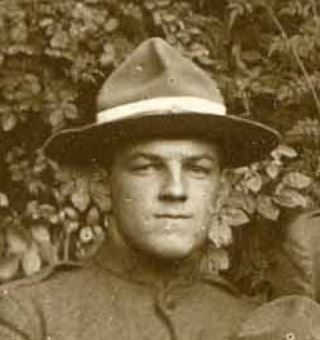
Herbert was among the ninety cadets (as they were now called) from the detachment who were housed initially in Peckwater Quadrangle of Christ Church College; his roommates were Parr Hooper and Robert Thomas Palmer. When all 150 men were moved to Exeter College around the middle of the month, Hooper wrote that he had “the same two roommates here that I had at Christ Church and we get along very well. We drew a convenient room on the second floor. There is no heat and we wash in cold water in basins in a little yard outside the court.”6
On November 3, 1917, after a month of ground school at Oxford, Herbert, along with most of the cadets, departed for Grantham in Lincolnshire to attend machine gun school at Harrowby Camp. There they spent about two weeks in classes and on the range learning to fire Lewis machine guns, with the prospect of another two learning about the Vickers machine gun.

The would-be aviators were in a holding pattern at Grantham, because there were as yet no openings for them at training squadrons. In his entry for November 8, 1917, the War Birds diarist writes: “Cal, Herbert, Fulford and Fry are sitting around the table now drinking port out of their canteens and writing home. Every one is fed up. I don’t see how we are going to stand three more weeks of this. Aren’t we ever going to fly?”
Wyton, London Colney
About a week later, places opened up at training squadrons for fifty of the cadets. Initially, according to Hooper, he and Herbert were among ten men selected to go to Doncaster.7 In the end Hooper was posted to Northolt, while Herbert, along with Earl Adams, Robert Alexander Anderson, Guy Maynard Baldwin, and Stanley Cooper Kerk, set out on November 19, 1917, for Wyton in Cambridgeshire. Adams, according to his R.A.F. service record, was assigned to No. 31 Training Squadron there, and this was probably where the other four trained as well.8
Herbert’s posting to Wyton lasted about a month. By December 18, 1917, he had been reassigned to No. 56 Training Squadron at London Colney, along with about other twelve men from the second Oxford detachment.9 The proximity to London meant that the men’s social life picked up considerably. Elliott White Springs, also at London Colney, wrote in his diary for January 18, 1918: “Much tattered and torn Herbert and I get back at 3 to find we’re in for a big strafe. So we make a last night of it and go up to Stamford”; the next day: “The C.O. gives us hell but no CB [confined to barracks].”10 Herbert’s name appears among the party goers and givers in War Birds entries for January 31, 1917, and February 16, 1918.
Training at London Colney began with flying Avros dual, i.e., with an instructor, and progressed to flying the same planes solo. Towards the end of February the men began to fly Sopwith Pups and in early March Spads.11
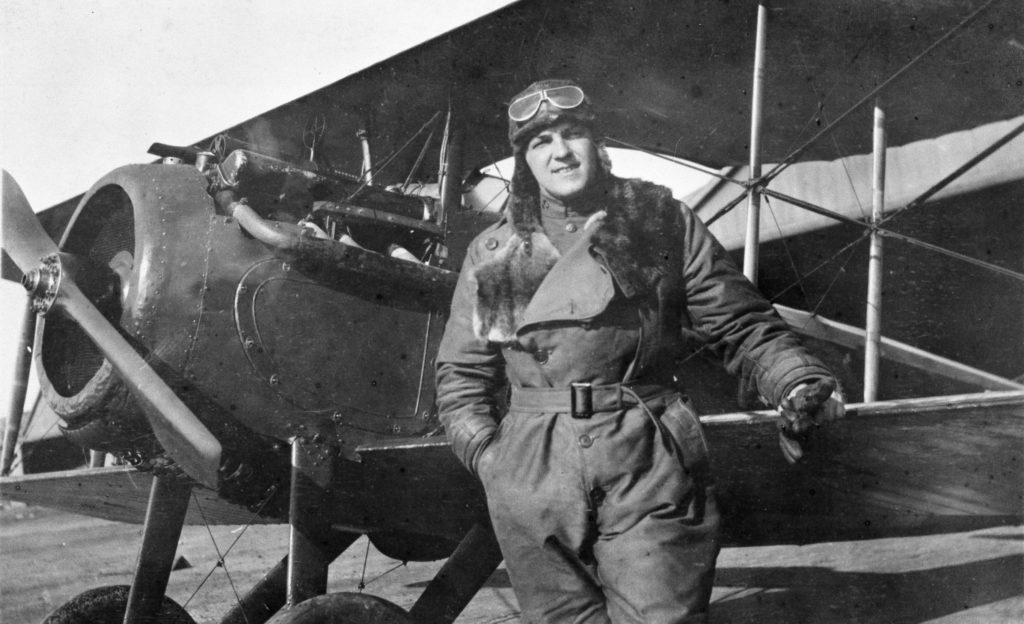
They practiced stunts and formation flying. On March 15, 1918, Herbert led Hooper and Francis Kinloch Read, all apparently flying Spads, forty miles cross country to his primary training squadron at Wyton: “It was great sport because we all are very chummy and went on sort of a lark. Frank and l had almost no idea where we were. We could watch each other all the time. We followed old Herb like a dog’s tail and trusted he knew where he was going.”12

Commission, Turnberry
By this time Herbert had flown enough hours and completed the requirements to qualify for his commission. Pershing’s cable forwarding the recommendation to Washington is dated March 6, 1918. Confirmation came unusually swiftly, in a cable dated March 17, 1918.13 The next day, Herbert, Hooper, and Read left London Colney for London, and the day after that travelled up to Turnberry in Scotland for training in aerial gunnery.14 The three of them shared a room at the luxurious hotel associated with the Turnberry golf course, which had been taken over by the R.F.C. By Hooper’s account, they enjoyed both the accommodations and one another’s company: “This is very luxurious living for war times. Turnberry is a famous golf course, right on the coast. It was developed by the railroad. We all live in the large swell hotel. We have beds, sheets, fine bath rooms, hot water etc. Herb, Frank, myself, and an R.F.C. chap are in one room. Our window looks right out over the Firth of Clyde and Irish Sea. There is a big army of WAACs here waiting on table and fixing up our rooms. The meals so far have been wonderful. The sea air is so bracing that I feel like eating all the time.”15 “[M]y roommates Tommy Herbert and Frank Read are getting so blooming congenial that when we get together here in the room to write we spend most of our time laughing and talking.”16
Hooper also describes their course at Turnberry: “We spend about 7 hours a day on the machine gun range. We have about 3 men using one gun and keep it pretty busy. The guns are arranged in aeroplane fuselages which are pivoted on a ball and socket joint. The regular aeroplane controls are all rigged to balance and point this fuselage just as though you were flying the bus in the air. We practice correcting gun stoppages and sighting on model aeroplanes set at various angles.”17

Ayr, ferrying
At the end of March, Herbert, Hooper, and Read moved on to the School of Aerial Fighting at Ayr, a few mile up the west coast of Scotland coast from Turnberry. For the first week there, however, the newcomers were in the “non-flying pool,” and occupied themselves with walks and bike rides in the countryside. Hooper writes that on one of these days, “Tommy (Herbert) and I took the bikes out this morning. We went down the coast south of the Heads of Ayr and rode down to the beach and played around on it with the bikes.
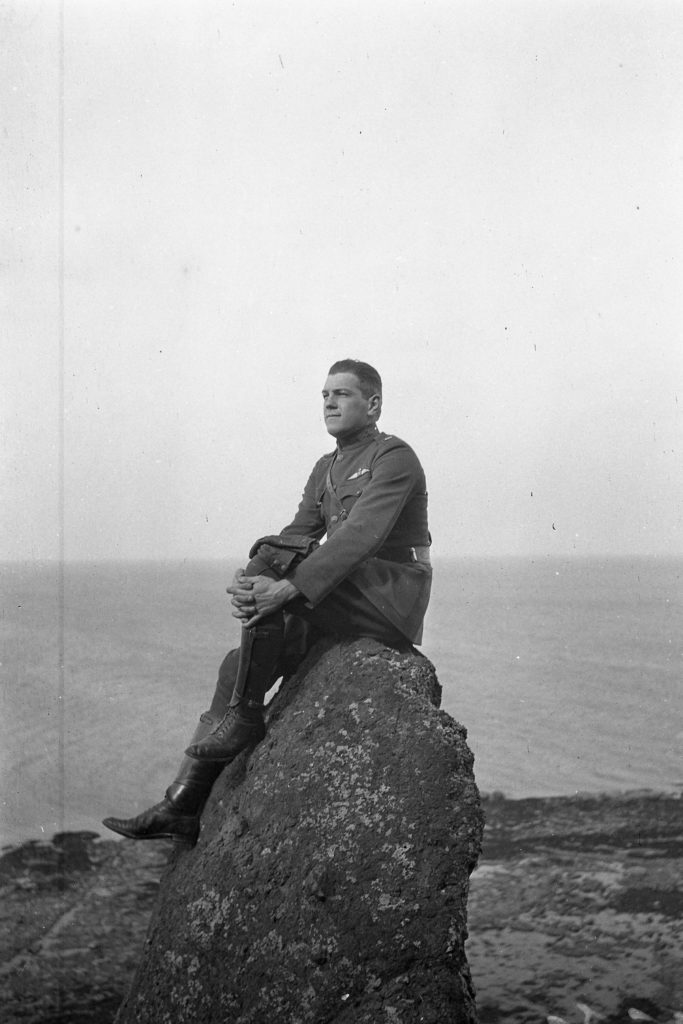
“Then we climbed up the rocks of the cliff of the Heads of Ayr and took some pictures. Coming home we cut into a little byroad, coasted down a winding and steep cow path. After several hair breadth escapes my bus finally chucked me down a ten foot bank into a newly plowed field. No casualties. Then we discovered we both had punctured our tires and had to walk them 3 miles home. We just got back in time to get the last end of lunch.”18 Other recreation at Ayr included baseball, a favorite pastime of Herbert’s.
Assuming Herbert’s training at Ayr resembled Hooper’s, he would have begun flying on about April 6, 1918, and have initially put in a fair amount of time on Avros, again, mostly solo. At some point he would have flown Spads, and then, towards the middle of April, finally have started flying an S.E.5, the plane he would fly in France. It is likely that Herbert, while at Ayr, encountered James McCudden, one of the celebrated pilots of No. 56 Squadron (not to be confused with No. 56 Training Squadron). McCudden, home from the front, was posted for a brief period to Ayr, and Hooper noted that he “has given us a couple of lectures.”19
On May 2, 1918, Read wrote in a letter home that he “was going to report to London tonight for overseas, but have to stay here a day or so for this court-martial. We are going to have about four men to try and expect to have a big time.”19a A photo of the officers at the court martial includes Herbert; there is no record of who was being tried or for what offense.
On May 10, 1918, Hooper had just completed a stint as a ferry pilot and was in London reporting to go overseas. There he found that “Tommy Herbert, Frank Read, and Paul Winslow . . . are in town starting to ferry pilot. They and [Roland Hammond] “Rit” Ritter, . . . [Duerson] Knight . . . and two other of us Am. pilots (who are starting to ferry) and myself all went to lunch at the American Officers’ Club. We all got in the back of one taxi and yelled and sang in a manner that probably shocked the Britishers and our superior officers that might have seen it. . . . We had a fine meal there, fried chicken on a meatless day, and lots of fun.”20
There is a passage in the War Birds entry for April 25, 1918, that mentions Herbert and Winslow: “Tommy Herbert and Paul Winslow were in the other night full of rumors. They have a scheme for getting switched from Camels, or rather Winslow has. They are ferrying and always take a Bristol Fighter. They are going to pass themselves off as Bristol pilots. Tommy is not so enthusiastic as he crashed a Bristol last week and broke a couple of ribs and sprained his back. I wish he’d sprain his throat so he couldn’t sing.” It is difficult to disentangle fact from poetic license, but the date is certainly off, given that the court martial detained Herbert and Winslow at Ayr into early May 1918. They may well have ferried Bristol Fighters, but that they had been destined for a Camel squadron is unlikely. (And Herbert’s singing, in duets with Winslow, was reported as popular and appreciated by squadron mates in France).21
France and No. 56 Squadron R.A.F.
On June 6, 1918, Herbert, Winslow, Read, and John L. C. Rorison were ordered to Boulogne to report “for assignment to duty, in connection with aviation.”21a They, along with a number of other men from the Oxford detachments, spent their first days in France marking time and digging trenches at a pilots pool at Rang-du-Fliers, about twenty miles south of Boulogne, as documented in a photo from the album of John Chadbourn Rorison.22 Postings to R.A.F. squadrons finally came at the end of the month. On June 29, 1918, Winslow wrote in his diary:
At last, after three weeks here (Rang du Fliers No. 2 Pool, France) Tommy and I were posted to 60 Squadron. At eleven o’clock 60’s tender came and picked us up, bag and baggage. We stopped at Abbeville and then carried on to 60, arriving at 2:30, and were told that we did not belong there but at 56, and were shipped off without any lunch. Poor Frank Read nearly cried when we left, and our impression of 60 was very poor. Arriving here [56] the change of atmosphere was very apparent. Captain [Gerald Joseph Constable] Maxwell, the CO—Major [Euan James Leslie Warren] Gilchrist—and everybody turned out to meet us. It seems they had us transferred when we were on route. I think we landed on both feet, as this is the top squadron in the RAF. We are south of Doullens and patrol from Albert to Arras.23
Maxwell had been an instructor at Ayr when Herbert and Winslow were training there in April. The reputation of No. 56 Squadron and its pilots was well established. It had been the first squadron to be equipped with the S.E.5, the best R.F.C. scout plane at the time. 56 deployed to France with the S.E.5 in April 1917. In June of the same year the squadron “upgraded” to S.E.5a’s, which had even better speed and climb. Starting in November 1917, No. 56 Squadron was assigned to the R.F.C./R.A.F. Thirteenth Wing, and supported the British Third Army by seeking out and destroying enemy aircraft along the Third Army’s front, roughly, as Winslow noted, from Albert north to Arras—although, with the start of the Battle of Amiens on August 8, 1918, they would be charged with assisting on the Fourth Army front just to the south, thus working east of Amiens.24 The pilots were divided into flights of, apparently, four or five pilots each, and often went out in patrols of two flights, one patrolling and stalking, the other protecting.
When Herbert and Winslow arrived at 56, the squadron was at Valheureux, about thirteen miles due north of Amiens. They had been there since March 25, 1918, i.e., since shortly after the opening of the German spring offensive.25 There were several Americans assigned to 56, but Winslow was the only member of the first Oxford detachment to serve with the squadron. In addition to Herbert, two second Oxford detachment men served with 56. Ritter had been assigned to 56 in May but had been sent to hospital in mid-June, probably suffering from Spanish flu; Wendell Ellison Borncamp was assigned to 56 around the same time as Herbert and Winslow.
Alex Revell, in High in the Empty Blue, his history of No. 56 Squadron during World War I, reports that the 56 Squadron record book for July and August is missing; there is thus no complete list of patrols flown during the period Herbert was there.26 Nonetheless, by using personal diaries and other sources, Revell is able to provide considerable day to day detail of the squadron’s activities.
The R.A.F. gave pilots new to the front three weeks to familiarize themselves with their squadron and the geography of the area where they would fly; only after this period did they go over the lines. There is a record of Herbert being taken by Maxwell to view the front line on July 7, 1918. He went up with Maxwell again on July 15, 1918—just a few days after the entire squadron had gone to Auxi-le-Château to attend the funeral of McCudden, killed in an air accident July 9, 1918.27
Over the lines
On July 19, 1918, at 6:30 in the morning, a patrol of two flights from 56, with Herbert in the top flight, led by William Otway Boger, set off; this was probably Herbert’s first time over the lines, but without the squadron record book or Herbert’s log book, this remains surmise. Herbert’s flight “attempted to attack four enemy scouts above them, but although they drove these east they could not close the range sufficiently to attack, finally leaving them east of Bapaume,” some twenty-five or thirty miles due east of the Valheureux aerodrome. They tried to attack three Fokker DVIIs north of Bapaume, over Boyelles, without success, and returned home.28
Bad weather meant some days with no flying. There were patrols on July 20 and 22, 1918; Revell does not mention Herbert in connection with them, but does not identify all those who flew those missions. Herbert did participate in a patrol on July 24, 1918, which happened to be Winslow’s first, and which the latter described in his diary: “Orders came through for a COP [close offensive patrol] at 7:15pm, upon which I was placed. Led by Bill Boger, with ‘Sambo’ [William Roy] Irwin and I flying right and left, with [Thomas Douglas] Hazen and Tommy Herbert behind, we left the ground and crossed the Lines at Albert at 6,000 feet. By the time we reached Arras, we were at 10,000 feet and then headed east into Hunland, crossing Bapaume at 15,000 feet.”29 Another flight of three S.E.5a’s from 56 led by Henry John Burden flew above them. Revell describes how “A little before 8:00, Boger’s formation flew under a formation of nine Pfalz D.IIIs . . . in an attempt to lure them down. [They] refused the bait and Boger turned the Flight and repeated the manoeuvre.”30 Boger’s second effort was successful: the Pfalz airplanes attacked the lower flight in which Herbert and Winslow were flying and were “sandwiched between the lower SEs and Burden’s flight—the latter being reinforced by a patrol of SEs from 84 Squadron”31 Winslow reported that “The dogfight lasted ten minutes, but there was so much going on that I didn’t have time to get scared.”32 Boger succeeded in downing two Pfalz (and received the D.F.C. in recognition of his actions this day), and all planes from 56 returned safely.33 Much of Winslow’s diary entry for that day is taken up not by the fight, but by the journey home through towering and endless seeming clouds, lightening, and rain; Herbert’s experience was probably similar.
Preparing to bomb aerodrome at Epinoy
During the last days of July 1918, pilots of No. 56 Squadron spent time practicing low bombing and strafing, not the type of warfare for which they were primarily trained. The Allied offensive that ultimately won the war was to open August 8, 1918, and air support included destruction of German air defenses in advance of the offensive. The two R.A.F. squadrons at Valheureux, 56 and 3, were assigned to bomb the German aerodrome at Epinoy, forty miles to the east, with Squadron Nos. 60, 87, and 11 flying protection and photographing results.
The raid was initially scheduled for July 30, 1918, but low clouds prompted the leader to abort the mission. It may have been rescheduled for the next day, but once again did not come off. Instead there was a picnic on the Somme; Herbert appears in pictures taken there, perhaps that day, or shortly before or after.34 It may be noted in passing that another popular form of recreation at Valheureux was baseball—Revell has been able to find and reproduce photos of 56’s team.35 American Mark Curtis Kinney flew Sopwith Camels with No. 3 Squadron R.A.F. and recalled that “At times pilots of the two outfits [3 & 56] met for a game of baseball.” He encountered Herbert at one of these, and the two exchanged opinions on their respective planes, with Herbert “completely sold on the S.E.5. . . . ‘I wouldn’t fly that damned pilot-killer Camel. . . . The S.E.5 has power and speed and it’s so stable you can fly it hands off. I know the Camel is the most maneuverable plane in the air, but I’ll take the S.E.5.’”36 Herbert perhaps knew of the string of fatal Camel accidents involving pilots in training that had occurred at Ayr in March shortly before he arrived there to train.
August 1918
On August 1, 1918, Winslow recorded in his diary that “The great bomb raid came off today, most successfully, to say the least. . . . The CO [Gilchrist], [Harold Arthur Sydney] Molyneux and I were the leading triangle, with Bill Boger and Hazen on the left. ‘Sambo’ Irwin, [John Kent] Blair and Herbert, the triangle on the right, and Hank Burden, [Cyril Brownlow] Stenning and [Herbert] Allen in the rear. Each of us had been assigned a different target, studied from actual photographs.
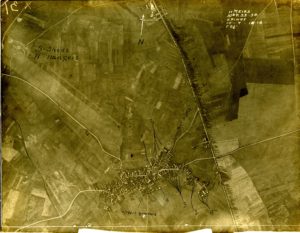
“At eleven we took off and climbed to 11,000 feet over Doullens, where the rendezvous was. . . . In all there were 65 machines in the raid. . . . Crossed the Lines at 12,000 and lost height down the Arras–Cambrai road to 4,000 feet, where the escort remained. It was then we saw Epinoy, our target. . . . The CO made a wide turn to the left and then dove, ‘Sambo’ and Tommy followed and then I came.”37 Flying at 200 feet, Herbert “killed 3 mechanics by machine gun fire and shot up hangars and billets.”38 In the course of ten minutes, the planes from 56 “dropped a total of 44 20lb Cooper bombs and expended the greater part of their ammunition, starting several fires in huts and hangars and setting four aeroplanes on fire,” all this without any loss to themselves.39 A congratulatory message arrived from the III Brigade commander, Charles Alexander Holcombe Longcroft (who had been “in a Camel watching from above”), that described the raid as a “complete success.”40
Revell indicates that uneventful patrols were flown on August 2 and 3, 1918, despite mist and rain; he does not indicate who flew. The next day (August 4, 1918) began rainy, but cleared by evening, as Winslow recorded in his diary, and, despite wind, “A Flight went on patrol, Bill Boger leading, Tommy and Stenning close, Molyneaux [sic] and I, rear. Left at 6:50 P.M., climbed to Lens, crossed the lines at 10,000, climbed to Albert, and patrolled at 14,000. Just at 7:48, I saw six Pfalz scouts below us and at the same moment climbed into the sun, and then dove. They were at 9,000 and started to stunt—they were clever. Tommy got one, and Bill fought another—it was Tommy’s first.”41 Herbert, who was flying S.E.5a B8423, reported:42

August 8, 1918
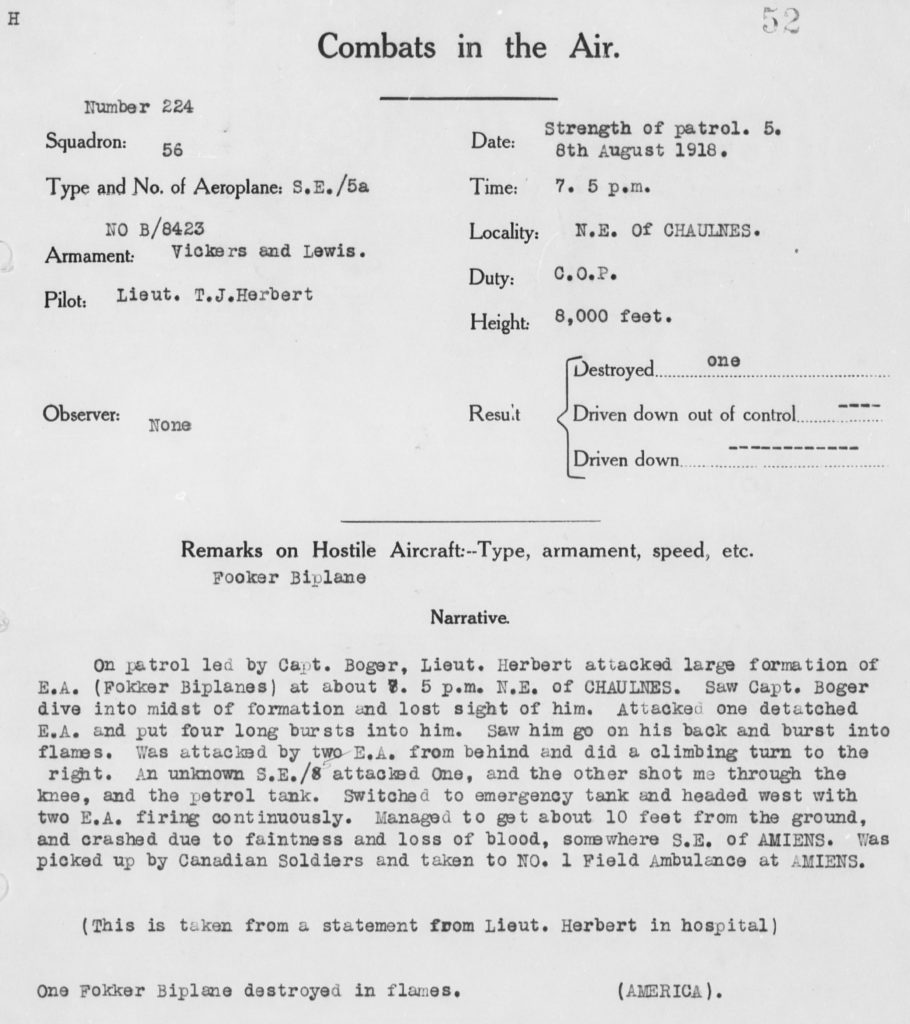 At the end of his diary entry for August 10, 1918, Winslow wrote: “Saw Tommy at the hospital; he is being sent to England.”52 From the field hospital Herbert was taken initially to No. 8 General Hospital at Rouen where a wounded Frank Read had been since mid-July. On August 12, 1918, Read wrote home that “My friend Tommy Herbert arrived here yesterday, with a fractured leg, how bad I don’t know yet, perhaps we can fly up to get somewhere to-gether, I hope so.” But the next day: “Tommy Herbert had a very bad leg, a piece gone out of the bone, so they sent him right away to England.”52a Herbert had been transferred to 37 Bryanston Square, a private house belonging to Lady Tredegar that had been turned into a small hospital for R.F.C./R.A.F. pilots.53 There, about two weeks later, the bed opposite him was given to his friend of No. 3 Squadron, Kinney, who had been wounded August 16, 1918.54 In early October Herbert once again received a visit from Winslow, who was by this time working at U.S. Air Service Headquarters in London.54a
At the end of his diary entry for August 10, 1918, Winslow wrote: “Saw Tommy at the hospital; he is being sent to England.”52 From the field hospital Herbert was taken initially to No. 8 General Hospital at Rouen where a wounded Frank Read had been since mid-July. On August 12, 1918, Read wrote home that “My friend Tommy Herbert arrived here yesterday, with a fractured leg, how bad I don’t know yet, perhaps we can fly up to get somewhere to-gether, I hope so.” But the next day: “Tommy Herbert had a very bad leg, a piece gone out of the bone, so they sent him right away to England.”52a Herbert had been transferred to 37 Bryanston Square, a private house belonging to Lady Tredegar that had been turned into a small hospital for R.F.C./R.A.F. pilots.53 There, about two weeks later, the bed opposite him was given to his friend of No. 3 Squadron, Kinney, who had been wounded August 16, 1918.54 In early October Herbert once again received a visit from Winslow, who was by this time working at U.S. Air Service Headquarters in London.54a
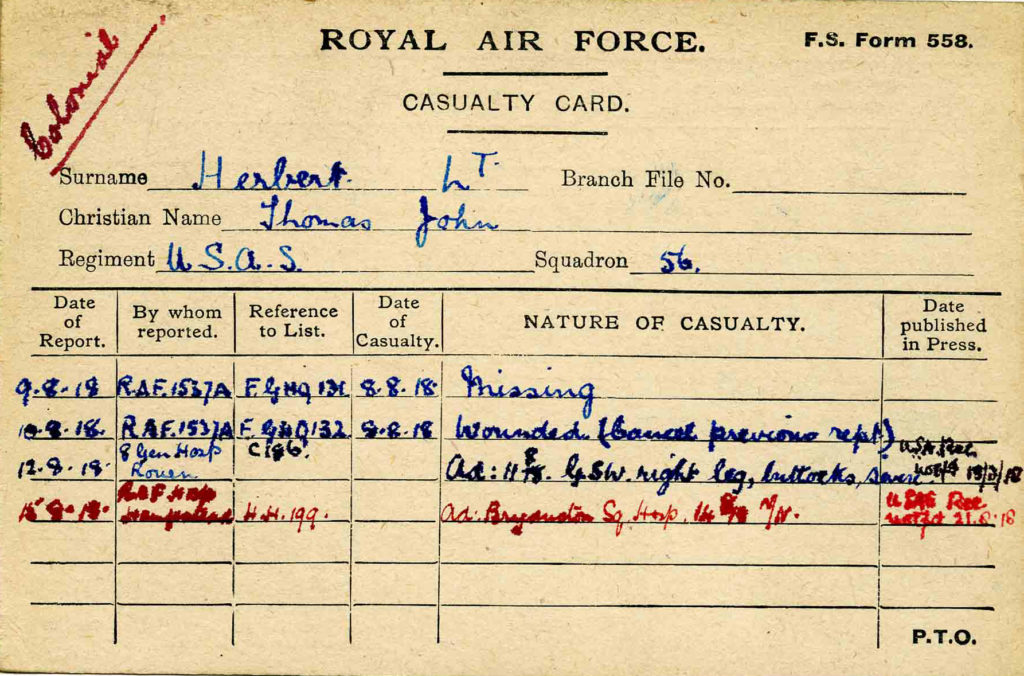
Awards
In the first half of September, Herbert was awarded the British Distinguished Flying Cross, proving Holleran wrong, as the award was in part for his “scrap” on August 4, 1918. The citation reads:55
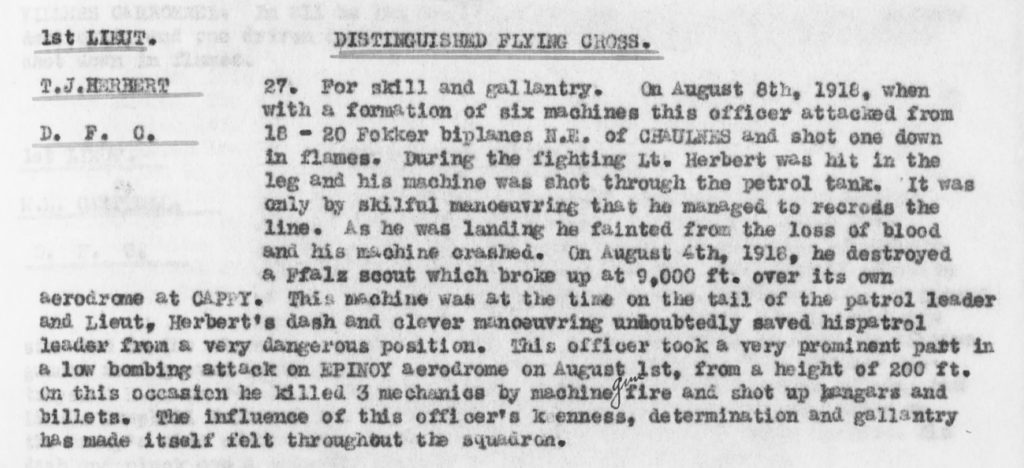
Before the end of the war, Herbert was also awarded the U.S. Distinguished Service Cross.56 He was apparently transferred at some point to U.S. Army Base Hospital No. 37 at Dartford in Kent and was part of a small contingent of sick and wounded from that hospital who sailed from Liverpool on January 23, 1919, on the H.M.S. Celtic and arrived back in the U.S. on February 2, 1919.57 Springs travelled home on the same ship, and, assuming they found one another on board ship, their conversations must have been lively.
Herbert returned to Western Reserve University to complete his law studies and went on to a distinguished legal career. He served one term as governor of Ohio as well as a term on the Supreme Court of Ohio.
mrsmcq February 9, 2018; Ayr, ferrying & France & 56 sections revised June 12, 2023
Notes
(For complete bibliographic entries, please consult the list of works and web pages cited.)
1 Herbert’s place and date of birth are taken from Ancestry.com, U.S., World War I Draft Registration Cards, 1917–1918, record for Thomas John Herbert. His place and date of death are taken from Ancestry.com and Ohio Department of Health, Ohio, Deaths, 1908–1932, 1938–2007, record for Thomas J. Herbert. The photo is a detail from one taken by Parr Hooper; see Hooper, Somewhere in France, “Thomas ‘Tommy’ John Herbert.”
2 On Herbert’s descent, see records available at Ancestry.com.
3 “John T. Herbert Dies.”
4 Western Reserve University, Catalogue of Officers, Graduates and Students of Western Reserve College and Adelbert College, 1826-1916, p. 75.
5 “Ground School Graduations [for September 1, 1917].”
6 Hooper, Somewhere in France, letter of October 27, 1917.
7 Hooper, Somewhere in France, letter of November [14], 1917.
8 On the men posted to Wyton, see Foss, diary entry for November 15, 1917. For Adams’s training squadron and date of assignment, see The National Archives (United Kingdom), Royal Air Force officers’ service records 1918-1919, record for Earl Adams.
9 Hooper, Somewhere in France, letter of December 18, 1918.
10 Springs, Letters from a War Bird, p. 77.
11 I’m assuming Herbert’s training proceeded along the same lines as that of Hooper, as documented in Hooper’s Pilot’s Flying Log Book.
12 Hooper, Somewhere in France, letter of March 31, 1918; the flight is dated based on Hooper’s Pilot’s Flying Log Book.
13 Cablegrams 691-S and 936-R.
14 Hooper, Somewhere in France, letter of March 20, 1918.
15 Ibid.
16 Hooper, Somewhere in France, letter of March 22, 1918.
17 Ibid.
18 This passage is an addendum to Hooper’s letter of April 3, 1918, and was probably written the next day.
19 Hooper, Somewhere in France, letter of April 13, 1918.
19a Read, letter of May 2, 1918.
20 Hooper, Somewhere in France, May 11, 1918, continuation of letter of May 9, 1918. Knight and Winslow were in the first Oxford detachment; the other men named in the second.
21 I have found no casualty card related to a crash involving Herbert during this period, but that does not prove that such a crash did not occur. Winslow’s diary entry for May 27, 1918, records his ferrying an S.E.5 to France. See Revell, High in the Empty Blue, pp. 340-41, for the comments of an otherwise unidentified “MacDonald” on Herbert and Winslow’s duets.
Knight and Winslow were in the first Oxford detachment; the other men named in the second.
21a Biddle, “Special Orders No. 83.”
22 Doyle, “War Birds Pictorial,” p. 43.
23 Quoted in Revell, High in the Empty Blue, p. 319. I have not been able to locate Winslow’s original diary; portions of it (not including this one) were published as “Attached to No. 56″; partial typescripts are in the Ola A. Sater Collection in the McDermott Library at the University of Texas at Dallas.
24 On their support of the Fourth Army, see Revell, High in the Empty Blue, p. 339.
25 Revell, High in the Empty Blue, p. 407.
26 Revell, High in the Empty Blue, p. 321.
27 On Herbert’s early flights, see Revell, High in the Empty Blue, pp. 324 and 328. On squadron attendance at McCudden’s funeral, see Winslow, quoted on p. 327 of the same work.
28 Revell, High in the Empty Blue, p. 329.
29 This is from Winslow’s diary entry for July 24, 1918, as it appears in Revell, High in the Empty Blue, p. 330. A slightly different transcription of the entry appears on pp. 314-15 of “Attached to No. 56.”
30 Revell, High in the Empty Blue, p. 330.
31 Ibid.
32 Winslow diary entry for July 24, 1918, from p. 331 of Revell, High in the Empty Blue.
33 Revell, High in the Empty Blue, pp. 330-31.
34 Revell, High in the Empty Blue, p. 333.
35 Revell, High in the Empty Blue, pp. 324–25.
36 Kinney, I Flew a Camel, p. 78.
37 Revell, High in the Empty Blue, p. 336; see the same passage on p. 315 of “Attached to No. 56.”
38 From Herbert’s D.F.C. citation; see “List of Honors and Awards, No. 1, Air Service, American E. F.,” p. 8.
39 Revell, High in the Empty Blue, p. 336.
40 Revell, High in the Empty Blue, p. 337, with quotation about Longcroft watching from Winslow’s diary.
41 From the August 4, 1918, entry in Winslow’s diary, from p. 316 of “Attached to No. 56.” See also, Revell, High in the Empty Blue, p. 338; Revell reports the patrol “crossing the Lines east of Arras at 12,500 feet.”
42 From Herbert’s combat report, reproduced as p. 46 of Individual Combat Records of Pilots with R.A.F. Revell, High in the Empty Blue, p. 338, reports the patrol stalking and attaching “six Pfalz D.III,” not eight. Herbert’s plane number on this combat report is given as “D8423,” an error for “B8423”; compare his combat report for August 8, 1918, below, and see the relevant entries in Robertson, British Military Aircraft Serials 1878–1987.
43 From the August 4, 1918, entry in Winslow’s diary, from p. 316 of “Attached to No. 56.” The last member of the patrol, Molyneux, attacked one of the Fokkers, but had to withdraw with engine trouble; a bad landing resulted in a sprained wrist; see Revell, High in the Empty Blue, p. 338.
44 Holleran, Holly His Book, p. 145.
45 See Revell, High in the Empty Blue, pp. 338-39.
46 “Attached to No. 56,” p. 316.
47 “Attached to No. 56,” p. 317.
48 Ibid.
49 Revell, High in the Empty Blue, p. 340; Revell notes two downed German pilots from that area that day: Ernst Aulenbacher and Erich Bethke.
50 “Attached to No. 56,” p. 317.
51 Individual Combat Records of Pilots with R.A.F., p. 52.
52 “Attached to No. 56,” p. 319.
52a Read, letters of August 12 and 13, 1918, from Read, Letters, papers, and photos.
53 Herbert, T.J. (Thomas John) [casualty card].
54 Kinney, I Flew a Camel, p. 98.
54a “Attached to No. 56,” p. 321.
55 Munsell, “Air Service History,” p. 166.
56 “Pershing Honors Gallant Aviators.”
57 War Department, Office of the Quartermaster General, Army Transport Service, Lists of Incoming Passengers, 1917 – 1938, Passenger list, sick and wounded, Base Section 3, Base Hospital 37, Dartford, on Celtic.

